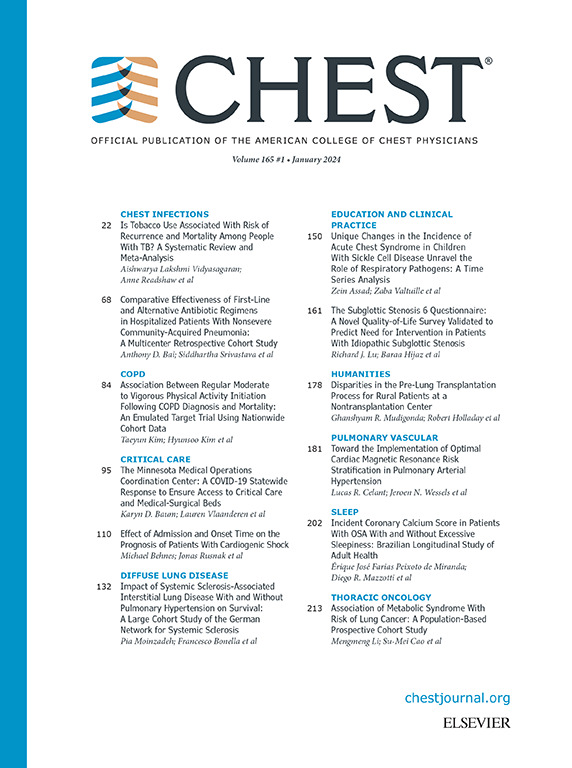HOW I DO IT: WHOLE LUNG LAVAGE IN PULMONARY ALVEOLAR PROTEINOSIS.
IF 8.6
1区 医学
Q1 CRITICAL CARE MEDICINE
引用次数: 0
Abstract
Pulmonary alveolar proteinosis (PAP) is a rare diffuse lung syndrome characterized by impaired surfactant clearance and alveolar filling, most commonly due to autoimmune neutralization of granulocyte-macrophage colony-stimulating factor (GM-CSF) by autoantibodies. Whole lung lavage (WLL) remains the cornerstone of treatment, yet procedural practices vary widely across institutions. This report presents a reproducible, evidence-aligned protocol for WLL developed across two high-volume centers, detailing perioperative management, technical execution, and follow-up. We describe our approach to patient selection, contraindication screening, anesthesia and airway strategy, and the stepwise lavage process using warmed saline instillation and drainage under general anesthesia with single-lung ventilation. Lavage is performed in two staged sessions, guided by effluent clarity and clinical tolerance. Intraoperative challenges such as hypoxemia, fluid spillover, or poor return are anticipated and addressed using structured response algorithms. Post-procedural care includes diuresis, lung re-expansion measures, and early mobilization, with discharge typically within 24-48 hours for elective outpatients. Most patients experience rapid improvement in symptoms, gas exchange, and functional capacity; however, recurrence is common, with one-third requiring repeat lavage within two to three years. Inhaled GM-CSF therapy is now considered post-WLL in all eligible patients, especially those with incomplete response or high relapse risk, prolonging remission and reducing the need for subsequent procedures. Our experience supports a combined strategy of lavage, adjunctive therapy, and longitudinal surveillance to achieve sustained disease control. By emphasizing multidisciplinary coordination, individualized risk assessment, and protocolized execution, this framework aims to enhance safety, reproducibility, and long-term monitoring to reduce recurrence and improve outcomes in PAP.怎么做:肺泡蛋白沉积症的全肺灌洗。
肺泡蛋白沉积症(PAP)是一种罕见的弥漫性肺综合征,其特征是表面活性剂清除和肺泡充盈受损,最常见的原因是自身抗体对粒细胞-巨噬细胞集落刺激因子(GM-CSF)的自身免疫中和。全肺灌洗(WLL)仍然是治疗的基石,但各机构的程序实践差异很大。本报告提出了一个可重复的、循证一致的WLL治疗方案,该方案由两个大容量中心开发,详细介绍了围手术期管理、技术执行和随访。我们描述了我们的方法,病人的选择,禁忌症筛选,麻醉和气道策略,逐步灌洗过程使用温生理盐水滴注和引流下的全身麻醉和单肺通气。灌洗分两个阶段进行,以流出物的清晰度和临床耐受性为指导。术中挑战,如低氧血症,液体溢出,或不良回报预期和解决使用结构化响应算法。术后护理包括利尿、肺再扩张措施和早期活动,选择性门诊患者通常在24-48小时内出院。大多数患者症状、气体交换和功能能力迅速改善;然而,复发是常见的,三分之一需要在两到三年内重复洗胃。吸入GM-CSF治疗现在被认为适用于所有符合条件的患者,尤其是那些不完全缓解或复发风险高的患者,可以延长缓解期并减少后续手术的需要。我们的经验支持灌洗、辅助治疗和纵向监测相结合的策略,以实现持续的疾病控制。通过强调多学科协调、个体化风险评估和协议化执行,该框架旨在提高PAP的安全性、可重复性和长期监测,以减少复发并改善预后。
本文章由计算机程序翻译,如有差异,请以英文原文为准。
求助全文
约1分钟内获得全文
求助全文
来源期刊

Chest
医学-呼吸系统
CiteScore
13.70
自引率
3.10%
发文量
3369
审稿时长
15 days
期刊介绍:
At CHEST, our mission is to revolutionize patient care through the collaboration of multidisciplinary clinicians in the fields of pulmonary, critical care, and sleep medicine. We achieve this by publishing cutting-edge clinical research that addresses current challenges and brings forth future advancements. To enhance understanding in a rapidly evolving field, CHEST also features review articles, commentaries, and facilitates discussions on emerging controversies. We place great emphasis on scientific rigor, employing a rigorous peer review process, and ensuring all accepted content is published online within two weeks.
 求助内容:
求助内容: 应助结果提醒方式:
应助结果提醒方式:


